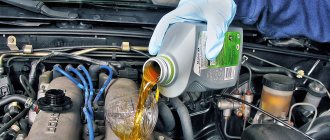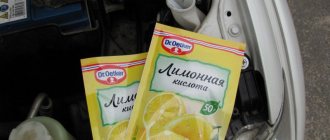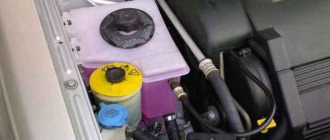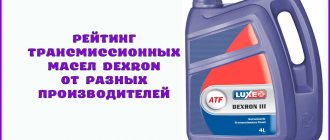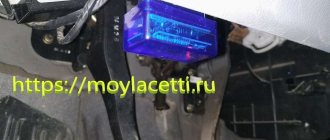The engine cooling system allows the engine components to maintain operating condition for the maximum amount of time.
Drivers are well aware that from time to time it is necessary to change antifreeze, which loses its properties in 2-3 years or 30-45 thousand kilometers. Not only is it possible to completely replace the coolant, but also top it up if necessary. At the same time, even if the coolant level is regularly maintained at the required level, the cooling system may become unusable and lead to engine malfunctions. To avoid this, experienced car owners recommend flushing the engine cooling system every 2 years. This procedure is performed on a paid basis by service specialists, but you can also do it yourself. As part of the article, we will explain how to flush the engine cooling system with your own hands, including without using a special liquid.
Why flush the engine cooling system?
The engine cooling system consists of a number of elements that must interact correctly with each other so that coolant is supplied to the hottest engine parts during operation. The most vulnerable element of the cooling system is the hoses, which can become clogged or torn due to excess loads.
During the operation of the car, sand, stones, insects get under the hood, dust and other contaminants form on the engine. Over time, some of the contaminants end up in the cooling system, mixing with the coolant. This leads to the formation of scale on various metal structural elements, which eventually flakes off and gets into the hoses. They become clogged, which reduces the efficiency of the cooling system or completely disables it.
If the coolant light is on on the instrument panel, the problem may not only be a lack of antifreeze, but also a problem with the cooling system itself, which will be quite expensive to solve if one or more elements need to be replaced. To avoid this, it is recommended to flush the engine cooling system every 2 years.
Types and methods of cleaning with industrial products
CO cleaning is carried out both externally and internally.
External cleaning of CO involves washing or blowing the radiator fins from the accumulation of fluff, dirt, and insect residues. Flushing is carried out under low pressure to avoid mechanical damage to the radiator honeycombs. In addition, the blades and fan housing are blown and wiped with a damp cloth.
The purpose of internal CO cleaning is to remove scale, rust and antifreeze decomposition products from the system. It is better to entrust internal cleaning of CO to professionals at special stands. But often there is not enough time or finances to visit a service station.
For self-cleaning of CO, auto chemical manufacturers have developed special cleaning agents. They can be divided into four categories:
- acidic;
- alkaline;
- two-component;
- neutral.
Scale and rust are removed with acid washes. Decomposition products of coolants are washed off with alkalis. Two-component washes are used for deep cleaning of CO and affect all types of contamination. Acidic and alkaline liquids are poured alternately.
Neutral flushes use catalysts that dissolve all contaminants to a colloidal state, eliminating clogging of the radiator honeycomb with decomposition products. The convenience of using neutral washes is that they are simply added to the antifreeze and do not stop the operation of the car. When using industrial CO flushes, be sure to carry out all stages of work according to the instructions. Failure to follow instructions can lead to disastrous results.
How to flush the engine cooling system
In car repair services, engine flushing is carried out with special products that can be purchased in stores specialized in engine consumables. There are many similar means, but the most famous of them are Lavr and Motorresurs. The cost of specialized products for flushing the engine cooling system is extremely high, and many drivers use ordinary distilled water to clean the system of foreign “garbage”. This method is cheaper, but also much less effective, since water does not fight scale, but only cleans out accumulated microparticles.
If the question arises about how to flush the engine cooling system inexpensively and effectively, you can use a solution of citric acid or Coca-Cola. Both liquids do an excellent job of cleaning scale and other contaminants from the cooling system.
Special liquids for flushing the cooling system
Those who are not going to try drinks, descalers, as well as folk remedies as a cleaner and do not trust them, they choose auto chemical products.
Manufacturers of auto chemicals are constantly developing new products, so there is a wide range of choice.
Classification of liquids by chemical composition:
- Neutral. Neutral are those with pH = 7. You can buy a ph meter and check what kind of water we drink (it’s good to drink alkaline water), etc. Neutral liquids do not have various alkaline and acidic impurities. Such liquids by themselves cannot clean the cooling system channels well.
- Acidic. Such liquids have a pH <7. Well used for purifying organic substances.
- Alkaline. Alkaline ones have a pH>7. Effectively dissolves organic contaminants.
- Two-component. Such liquids contain both acidic and alkaline elements. Effectively dissolve and remove scale, rust, and various deposits resulting from the breakdown of antifreeze or antifreeze.
It is advisable to use only one liquid based on its chemical composition. Not so, first alkaline, then acidic, or vice versa.
Among the TOP auto chemical products for flushing the engine cooling system are the following:
- Lavr Radiator Flush Classic (Lavr Radiator Flush Classic) is a chemical product from Russian manufacturers. Effectively used for complete cleaning of the internal combustion engine cooling system. The cost of a half-liter container of Lavra is about 300 rubles.
How to use LAUREL:
- Drain the coolant.
- Pour in two-component LAUREL. Volume 430 ml is enough.
- We fill the system with water after Laurel.
- We start the engine and let it idle for 30 minutes.
- Shut off and drain the fluid.
- Fill with distilled water for rinsing.
- Start the engine and let it idle for 15 minutes.
- Drain this liquid and add new antifreeze or antifreeze.
After such cleaning, deposits of scale, rust and dirt will be removed from the system. The pump and antifreeze will last longer.
2. LIQUI MOLY Kuhler-Reiniger (Liqui Moly Kahler-Reiniger) - a product from a German manufacturer of chemicals for cars. The cost is around 500 rubles for a 300 ml can. There are no aggressive substances in the composition. If you need to flush the radiator channels and the system as a whole from rust and oil deposits, then Liqui is perfect for this. Does not destroy rubber and plastic products.
To prepare flushing fluid for a car’s cooling system, one 300 ml bottle is enough.
How to use LIQUI MOLY:
- Drain some of the old fluid from the system.
- Pour the entire contents of the can directly into the radiator.
- Start the engine and let it idle for 30 minutes or you can also drive it.
- Drain the liquid. What usually comes out is a dirty brown liquid.
- Rinse with distilled or boiled water.
- Fill with new antifreeze or antifreeze.
3. Hi-Gear Radiator Flush-7 minute - a product from American manufacturers. The price of a 325 ml vessel is about 6 dollars. Used in different countries to clean the cooling system of cars and trucks. The working time declared by the manufacturer is 7 minutes. There is also a 5-minute action. After using High Gear Radiator Flush 7, the efficiency of the radiator increases by 1.5 times, fluid circulation in the system is restored, and it does not corrode the seal of the pump and other rubber-plastic products.
Source: autostuk.ru
The need to flush the cooling system arises when you replace the coolant with a liquid of a different brand or when you notice unsatisfactory operation of the system. A considerable number of reagents are produced for this purpose, however, many drivers use improvised means. Having unsuccessfully flushed the cooling system with a store-bought compound, I tried citric acid.
To begin with, having decided to use citric acid, I bought one bag and rinsed the kettle with it. The method is widely known: fill the kettle with water, add a packet of acid and a piece of aluminum foil, boil, and leave to stand for half an hour. We admire the clean teapot and untouched foil. Over a cup of tea, we ponder the results of the experiment.
- Citric acid is safe for aluminum radiators, but removes scale. The silicate film in the cooling system is not scale.
- For a 1.7 liter kettle, 1 sachet weighing 30 grams is enough. This means that for a cooling system with a volume of 8 liters you need 4...5 bags. (I took 10 bags, maybe that's too much).
After rummaging around in the kitchen, I found a jar with a volume of about a liter. I poured acid from sachets into a jar and poured boiling water over it. Having loaded the trunk with containers of water, I went to the washing place.
To flush the cooling system, the antifreeze must be drained. I was going to pour it back in later. Therefore, it was necessary to drain the antifreeze clean. I reached under the car and unscrewed the mudguard. He placed the basin. I unscrewed the cap on the radiator. (It is convenient to regulate the fluid flow rate using the expansion tank plug). Drained from the block.
I poured the washing solution: first diluted citric acid, then just water according to the level. I started it, warmed it up to 50 degrees at idle, then added gas, accelerated the engine to three thousand revolutions and warmed it up to one hundred degrees. This took about 10...15 minutes. I warmed it up at high speeds so that there was good circulation through both the radiator and the stove. The engine was turned off, slowly cooled down and gurgled with escaping gases.
Ten minutes later, when I started it, I noticed a rapid increase in temperature. This is a sign of lack of circulation! Immediately turned it off. Opening the hood, I discovered an increased fluid level in the reservoir. The released gases displaced the water into the tank. I removed one hose for heating the throttle assembly - the level dropped. Then I did just that: I warmed it up, turned it off and immediately removed the hose of the throttle assembly - so that gas could escape freely. I didn’t leave the parking lot - I shouldn’t let off the gas at every intersection.
An hour later, I poured it into the washing solution and washed it four times with just water (the blackness in the drained water disappeared the third time).
My conclusions are as follows. To flush the cooling system, the exposure time of the solution is important. Simple citric acid is a cheap and reliable means of flushing the cooling system. Use it first, and only then branded products, the composition of which is unclear. When flushing the cooling system, do not limit yourself to idle speed, drive the engine at three thousand - to create a strong circulation of the flushing solution.
And a few more interesting ways:
Source:
Source: www.liveinternet.ru
Hi all! I carried out a CO flush using well-proven citric acid. First things first. I didn’t buy citric acid in bags, but bought it by weight - in total, the whole procedure took me about 3 kg of this miracle powder. We also purchased 15 liters of distilled water and, of course, antifreeze. I didn’t think for a long time which one to get, I bought Sintec Lux-OEM G12 in red. Yes, by the way, both radiators were snotty before flushing. Having read the recently posted result of a large test of coolants, I came to the conclusion that the radiators could not have started leaking like that on their own in 1.5 years, because there were no stones and the system was always filled - the Alaska antifreeze helped, which from that very day never again I will not use it, and I will not wish it on anyone. Test by the magazine "Behind the wheel" Results of phased array research Changing radiators is expensive, so after searching online I bought Liqui Moli CO sealant. In a week I will post here and on their forum about the results of the application. The procedure itself took me 2 days. I apologize, I didn’t take any photos the first day of work. I think everyone understands what comes out after the first few procedures. I will describe the algorithm of actions. By the way, in some posts on D2 people write about the need to use distillate. Friends, citric acid is needed to fight scale, so using distilled water makes no sense, and it’s also expensive. 1. I drained the antifreeze (or what was poured in) - absolutely black liquid. 2. I pour lemon into the water in the proportion of 1 large cup per bucket of water, stir and pour into the radiator. 3. I start the engine and spin it for 15-30 minutes at different speeds - you can go for a drive. After a while I wait until it cools down and drain the black slurry again. P.p. 2 and 3 were repeated 6 times. At the 6th drain of the “working” the first gaps appeared. Next, I poured a less concentrated solution (1/2 cup per bucket) and drove the car into the garage. I had to drive around for a bit without touching anything. Day 2 of work has arrived. Strictly speaking, the washing algorithm is the same.
There was no point in rinsing any more in my opinion. After that, I poured in the distillate and added sealant to it strictly according to the instructions. I let the engine run for about 40 minutes, although the manufacturer writes that 10 is enough. I didn't want any remaining sealant left in the system, so I thought the sealant would do its job and I'd salt the rest. That's what I did. I drained the water and sealant, poured in clean distillate, turned the engine for about 1 minute and drained it. After all these procedures, fresh antifreeze was added. This is how the job turned out. What can I say. The car began to accelerate a little easier, the temperature on the highway dropped to 80 degrees (by the way, who can say whether this is harmful for the engine or normal?), the engine itself began to run quieter. Price: Sealant - 310 rubles. Antifreeze 10 l - 750 rub. Distilled water 15 l - 150 rub. Citric acid 3 kg - 300 rub. Tap water is priceless. Good luck to all!
Continuing the topic...
Source: www.drive2.ru
How to flush the engine cooling system
The process of flushing the cooling system is quite simple, and it consists of the following steps:
- The car engine warms up a little, then turns off and you need to wait a while until it cools down a little;
- Next, the plug is unscrewed and the old coolant is drained from the engine. Attention: Do not drain the coolant on a hot engine - this can cause burns and spray antifreeze under pressure;
After this, you need to fill in the cooling system cleaning agent. Some of them must be diluted with distilled water. If you are using citric acid or Coca-Cola for flushing, specific recommendations for using these fluids to flush the engine will be given below. In cases where specialized products are used, it is necessary to follow the instructions on the packaging;
- Next, you need to let the engine run for some time with the liquid filled in to clean the cooling system. Time recommendations depend on the type of fluid used;
- After washing, the liquid is drained and clean water is poured into the cooling system to remove any remaining detergent. The procedure for draining and filling water may need to be repeated several times;
- The last step is to add new coolant to the cooling system. Attention: it is better to choose the same antifreeze that was poured into the cooling system before flushing.
Thorough flushing of the cooling system is necessary to remove formed sediments, dirt, corrosive elements and harmful impurities that can impair the stability of the system. We strongly recommend that you fill in new antifreeze after flushing the cooling system, since the old fluid, even if the car has not driven many kilometers on it, contains particles of contaminants.
How does citric acid act on scale?
Before moving on to the question of how to clean a washing machine with citric acid, let’s consider the principle of how acid acts on scale. So, on the one hand, we have the acid (HOOCCH2) 2C (OH) COOH, on the other, potassium and magnesium salts that react with it. As a result, the scale softens and collapses, freeing the heating element from its “coat”.
The main thing is to use it correctly
For a small machine for 5 kg of laundry, 70 g of powder is enough, for larger models - 100 g. Another important point is maintaining the required temperature - within 70 degrees. If you start cleaning at 90 degrees, you can damage the rubber bands and gaskets.
How to flush the engine cooling system with citric acid
It is no secret that an acidic environment allows you to overcome scale and rust, and it is advisable to use it to clean the cooling system. The most affordable way to create an acidic environment yourself in large volumes is to use a mixture of citric acid and water. The resulting solution allows you to get rid of contaminants in the engine cooling system.
Some features of flushing the cooling system with citric acid:
- To create a solution for severe contamination, it is recommended to use 1 kilogram of citric acid per 10 liters of water. If the contamination is moderate, the amount of citric acid per 10 liters can be reduced to 800 grams;
- After citric acid is poured into the cooling system, you need to drive a few kilometers by car (let the engine run for 10-15 minutes at medium speed without sudden acceleration), and then leave the product for another 45 minutes;
- Before adding new antifreeze, it is necessary to thoroughly clean the system of any remaining citric acid; to do this, flushing the cooling system with water is repeated 3-4 times.
Citric acid shows itself to be no worse than many professional cooling system cleaning products.
How to replace citric acid in canning
When preparing compote, jam or jam from serviceberry, quince, gooseberry or chokeberry, you cannot do without citric acid, because it is what gives them their piquant sourness. In this case, instead of citric acid, you can use orange or lemon zest and citrus juice or applesauce and zest.
Sour berries instead of citric acid
Citric acid is a component often used in preservation to highlight the taste of sweet berries and fruits or to protect compotes and jams from spoilage. Some recipes for canned and pickled vegetables also recommend using citric acid as a preservative. Typically, recommendations to replace vinegar with citric acid are associated with gastrointestinal problems. But if citric acid is not on hand, then you can use whole berries instead:
- red currant;
- cranberries;
- lingonberries.
Sour berries will add an original flavor to pickled cucumbers, zucchini, peppers, and tomatoes.
On a note! Instead of citric acid when canning vegetables, you can use the following in a 1 liter jar:
- 200 g red currants or,
- 200 g rowan or,
- 100 g lingonberries or,
- 100 g cranberries or,
- 100 g Chinese lemongrass or,
- 0.5 liters of fresh tomato juice or,
- 100 g sorrel or,
- 1 sour apple or
- ½ small bunch of grapes or,
- juice of ½ lemon.
The berries are washed and placed in jars with vegetables, and it is recommended to pre-boil and puree the sorrel, and then add it to the jars. Based on sorrel decoction, you can prepare an excellent brine for pickling cucumbers. By using sour berries, fruits and vegetables as natural preservatives, homemade preparations will become not only tastier, but also healthier.
Natural juice instead of citric acid
Juices obtained from fruits and berries contain a significant amount of organic acids and are quite capable of replacing citric acid in the preparation of some dishes:
- desserts;
- compotes, jelly and other drinks;
- jams and marinades;
- sauces and gravy.
On a note! Citric acid is often used as an essential component of meat marinades. For example, a leg of lamb is marinated in a marinade with the addition of citric acid: ¼ teaspoon per 2 kg of meat with bone. In this case, you can use grape or pomegranate juice instead of acid. They will not only make the meat tender, but also add a pleasant taste.
For these purposes, it is better to use natural, unsweetened juice:
- grape;
- pomegranate;
- cherry;
- cranberry;
- apple.
On a note! Sour fruit or berry juice, added when cooking jam, will allow the fruit not to lose its attractive appearance and the jam not to become sugary.
How to flush an engine cooling system with Coca-Cola
It has long been known that Coca-Cola drink can be used in everyday life as a cleanser. The composition of soda contains various components that allow you to clean rust and dirt. Coca-Cola can also be used to clean the engine cooling system.
Attention: It is recommended to use original Coca-Cola, and not its analogues, which may contain other components that are ineffective for cleaning the cooling system.
Some features of flushing the engine cooling system with Coca-Cola:
- The operating time of the engine on Coca-Cola should be minimal - 4-5 minutes, after which the engine should be turned off and the drink allowed to remain in the cooling system for another 30-35 minutes;
- Washing with water after Coca-Cola must be done more thoroughly than after other products, since sugar elements can settle on the tubes of the cooling system.
It is worth noting that upon completion of cleaning the cooling system of contaminants using Coca-Cola, it is recommended that after adding antifreeze, start the engine with the radiator cap open so that the remaining air bubbles come out. Next, turn off the engine and add coolant to the resulting additional space.
( 451 votes, average: 4.41 out of 5)
How to check the idle speed sensor
Car calipers are knocking: diagnostics and troubleshooting
Related Posts
Is it possible to clean a dishwasher with citric acid?
Many housewives perceive washing household electrical appliances as a complicated procedure. They can be cleaned using either purchased household chemicals or self-made compounds.
The dishwasher requires regular cleaning due to its functioning. Contact of heating elements with water causes the formation of lime deposits. Scale impairs thermal conductivity. This causes an increase in electricity consumption. Plaque shortens the life of the device.
You can clean your dishwasher with tribasic carboxylic acid. The advantage of the powder is that it is not harmful to health due to its naturalness.
The source of organic matter is plant materials. It is considered a safe means for cleaning plastic and metal surfaces. The powder is used for the following purposes:
- removal of scale formed on the heating elements of devices;
- rust removal;
- enhancing the cleaning effect.
Tribasic carboxylic acid is a good analogue of household chemicals intended for cleaning dishwashers. Many formulations include organic matter as a main component.
Important! Citric acid is a dishwasher safe detergent. However, it is essential to use the recommended amount of powder.

